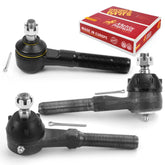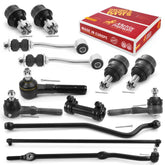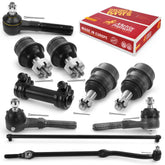DIY Center Link Installation: Step-by-Step Guide
The center link, also referred to as a drag link or a relay rod, plays a crucial role in a vehicle's steering and suspension system. Its various components work together to transmit steering input from the steering gear (gearbox or rack-and-pinion) to the steering knuckles, thus controlling the movement of the front wheels.
It's imperative to note that installing a center link, also known as a drag link, requires both mechanical knowledge and the right tools. The process may differ depending on the specific make and model of the vehicle, so it's essential to consult the vehicle's repair manual or seek the guidance of a professional mechanic if you're unsure. Here's a general overview of the steps involved in installing a center link:
- Gather Tools and Parts:
To replace the center link on your vehicle, you will need to gather the appropriate tools and parts, including wrenches and sockets of the appropriate sizes, a torque wrench, jack and jack stands, a ball joint separator or pickle fork, and a grease gun if applicable, as well as a repair manual specific to your vehicle. Additionally, you may want to consider using a thread locker for added security.
- Preparation:
Park the vehicle on a flat, level surface and engage the parking brake. Then loosen the lug nuts on the front wheels.
- Lifting the Vehicle:
Use a jack to lift the front of the vehicle and secure it with jack stands. Then ensure that the vehicle is stable and safely lifted.
- Removing Old Center Link:
Locate the old center link. It connects between the steering gear and the steering knuckles. Then remove any hardware (nuts, bolts, etc.) securing the center link to the steering gear and steering knuckles. Use a ball joint separator or pickle fork to disconnect the ball joints from the steering knuckles.
- Installing the New Center Link:
Attach the new center link to the steering gear and knuckles using the appropriate nuts and bolts. Then tighten the hardware according to the manufacturer's specifications. Use a torque wrench to ensure proper torque values.
- Reconnecting Ball Joints:
Reconnect the ball joints to the steering knuckles. Use new cotter pins or locking nuts if required by the manufacturer.
- Tightening and Torquing:
Ensure that all hardware is tightened correctly and torqued to the recommended specifications.
- Wheel Alignment Check:
After installing the center link, it's essential to check the vehicle's wheel alignment. Misaligned wheels can lead to uneven tire wear and poor handling.
- Lowering the Vehicle:
Carefully lower the vehicle from the jack stands using the jack.
- Tightening Lug Nuts:
Tighten the lug nuts on the front wheels in a crisscross pattern.
- Test Drive:
Take the vehicle for a test drive to ensure that the steering is responsive and the vehicle handles correctly.
It is crucial to keep in mind that the steps and details of installing your vehicle's part may vary according to its design. However, if you lack the necessary tools or are not confident in your abilities, it is highly recommended to seek the assistance of a professional mechanic for installation and any required adjustments. Their expertise can ensure proper installation and prevent any potential mishaps. Therefore, it is advised to take necessary precautions and avoid taking any risks. Choosing the part you need is another thing that you should not risk! Visit https://metrixpremiumparts.com/ to find the best-fitting qualified part specifically for your own car.








